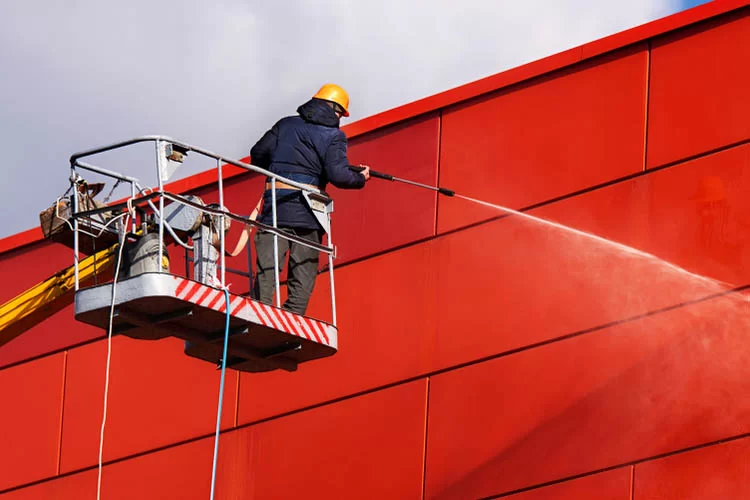
Introduction
Preparing a surface for painting is a crucial step that often goes overlooked. The quality of your paint job hinges on the cleanliness and readiness of the surface beneath it. Improper preparation can lead to poor paint adhesion, premature peeling, and an overall lackluster finish. To ensure your painting project’s success, it’s essential to understand the different methods of surface cleaning, particularly abrasive washing and pressure washing. In this post, we’ll dive deep into these two techniques, exploring their strengths, weaknesses, and ideal applications.
What is Abrasive Washing?
Abrasive washing, also known as media blasting, is a powerful cleaning method that uses abrasive materials propelled at high speeds to remove stubborn grime, paint, and other contaminants from a surface. The most common abrasives used include sand, glass beads, crushed walnut shells, and sodium bicarbonate. The choice of abrasive depends on the surface material and the desired level of cleaning.
Abrasive washing is particularly effective on tough, resilient surfaces like concrete, brick, and metal. It’s an excellent choice for removing heavy buildup, rust, and old, peeling paint. However, it’s important to note that abrasive washing can be aggressive and may damage softer surfaces like wood or delicate masonry. It also requires specialized equipment and safety precautions, as the abrasive particles can pose health risks if inhaled.
What is Pressure Washing?
Pressure washing, on the other hand, relies on high-pressure water jets to blast away dirt, grime, and loose paint. The pressurized water, typically delivered through a specialized nozzle, can effectively clean a wide range of surfaces without the need for abrasive materials. Pressure washers come in various sizes and power levels, making them adaptable to different projects.
Pressure washing is a go-to method for cleaning exterior surfaces like siding, decks, driveways, and fences. It’s also useful for preparing surfaces for repainting by removing chalking and loose paint particles. However, pressure washing has its limitations. It may not be as effective on heavily soiled or stained surfaces, and improper technique can lead to damage, especially on softer materials like wood or stucco.

Comparing Techniques: Abrasive vs. Pressure Washing
When it comes to effectiveness, abrasive washing generally outperforms pressure washing on heavily soiled, rusty, or paint-encrusted surfaces. The abrasive particles can penetrate deeper into the surface, breaking up stubborn contaminants that water alone may not remove. However, pressure washing is often more cost-effective and environmentally friendly, as it doesn’t generate the same amount of waste or require the disposal of used abrasive materials.
The environmental impact of both methods should be considered. Abrasive washing can generate significant amounts of dust and debris, which may contain hazardous materials like lead paint. Proper containment and disposal are crucial. Pressure washing, while less waste-intensive, can still produce wastewater that may contain pollutants. It’s essential to follow local regulations and best practices for wastewater management.
Choosing the Right Method for Your Project
Ultimately, the choice between abrasive washing and pressure washing depends on several factors. Consider the surface material and its condition, the type of contaminants present, and the desired outcome. For example, if you’re preparing a heavily rusted metal surface for repainting, abrasive washing may be the most effective option. On the other hand, if you’re cleaning a moderately soiled deck before staining, pressure washing could be sufficient.
When in doubt, consult with a professional. Experienced painters and surface preparation specialists can assess your specific situation and recommend the most appropriate method. If you decide to tackle the project yourself, be sure to follow safety guidelines, use the proper equipment, and protect yourself with appropriate gear like goggles, gloves, and a respirator mask.
Maintenance and Care After Washing
Once your surface is cleaned and ready for painting, it’s important to maintain its condition to ensure the longevity of your paint job. Regular cleaning with mild detergents and soft brushes can help prevent the buildup of dirt and grime. Promptly addressing any signs of paint failure, like peeling or cracking, can also help extend the life of your paint.
If you encounter any issues post-washing, like surface damage or persistent stains, don’t hesitate to call a professional for guidance. Remember, the success of your painting project relies heavily on the quality of your surface preparation. By investing time and effort into thorough cleaning and maintenance, you’ll be rewarded with a beautiful, long-lasting finish.
Conclusion
Abrasive washing and pressure washing are two powerful tools in the quest for the perfect paint job. By understanding their strengths, limitations, and appropriate applications, you can choose the method that best suits your project’s needs. Whether you opt for the heavy-duty abrasive approach or the more versatile pressure washing, always prioritize safety and environmental responsibility. With the right preparation and maintenance, your newly painted surface will stand the test of time, providing years of beauty and protection.
Tags:

Easy Guide to Transforming Your Workspace with Our Renovation Services
More
The Top 5 Benefits of Professional Air Duct Cleaning in Atlanta Offices
More
The Art of Professional Painting: How Professional Painters Elevate Your Business
More
Choosing the Right Colors for Your Office Building Painting Project
More